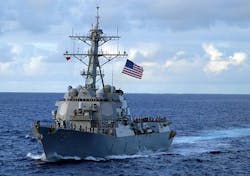Navy orders 12 advanced AN/SPQ-9B shipboard radar systems from Northrop Grumman
Officials of the Naval Sea Systems Command in Washington are asking Northrop Grumman to provide 12 AN/SPQ-9B radar system to enable Navy surface warships to detect and track fast low-flying anti-ship missiles with low radar cross sections in heavy radar clutter.
The high-resolution, X-band AN/SPQ-9B radar enhances the ability of ship crews ability to defend their vessels against small high-speed threats like surface-skimming anti-ship missiles, and will be integrated with the ships' fire-control systems, Northrop Grumman officials say.
The multimission radar system is designed to detect small fast-moving targets in the presence of clutter from ocean waves, rain, and land returns, as well as chaff and jamming.
The AN/SPQ-9B is a multimode pulse Doppler radar that detects all known and projected sea skimming missiles, company officials say. Additional capabilities now in final development include 3-D volumetric search.
The system uses a high-resolution, track-while-scan radar to provide real time acquisition and automatic tracking of multiple surface and air targets while maintaining the surface detection, gunfire control, and navigational capabilities, Navy officials say.
AN/SPQ-9B makes the most of commercial off-the-shelf (COTS) and non-developmental item (NDI) equipment. The radar interfaces with ship combat systems via various command and control systems including the Cooperative Engagement Capability, AEGIS/LAN interconnect system, MK160 gun weapons system, and Aegis weapon system.
The AN/SPQ-9B scans out to the horizon and performs simultaneous and automatic air and surface target detection and tracking of low flying anti-ship cruise missiles, surface threats, and low-and-slow-flying aircraft, unmanned aerial vehicles (UAVs) and helicopters, Navy officials say.
The radar consists of four air-cooled below-deck cabinets, a motor generator, and one above-deck antenna designed to have a small radar signature for stealth ship design. The radar meets all MIL-STD-901D shock requirements and is an unattended system.
Related: Navy chooses shipboard radar power amplifiers from L3 Electron and CPI Beverly Microwave
The AN/SPQ-9B radar includes built-in training aids that support stand-alone and team training with the combat system. The AN/SPQ-9B radar has completed all U.S. Navy qualification testing and is in full-rate production.
The radar is installed on Nimitz-class aircraft carriers, San Antonio-class amphibious transport dock ships, Ticonderoga-class cruisers, Coast Guard Legend-class national security cutters, as well as Wasp-class and America-class amphibious assault ships. The AN/SPQ-9B radar also is to be installed on Arleigh Burke-class destroyers and on three Royal Australian Navy air warfare destroyers, Navy officials say.
This contract combines purchases for the U.S. Navy and the government of Japan under the Foreign Military Sales (FMS) program. Northrop Grumman will do the work in Baltimore and in Bethpage, N.Y., and should be finished by August 2019.
For more information contact Northrop Grumman Electronic Systems online at www.northropgrumman.com, or Naval Sea Systems Command at www.navsea.navy.mil.
